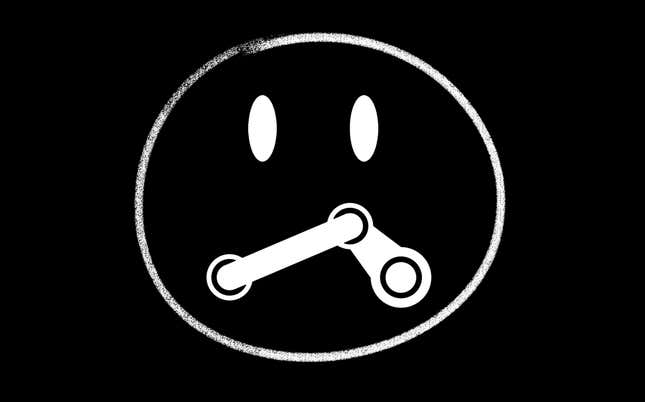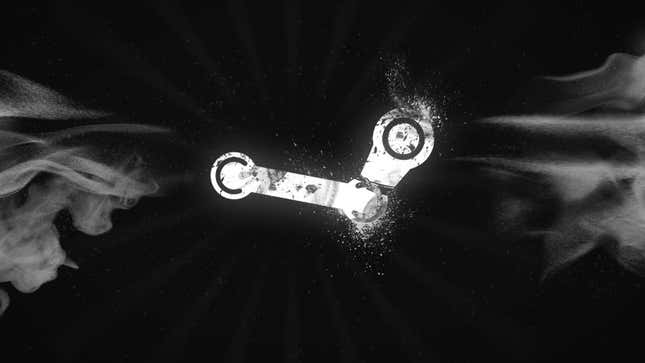
It’s been a dramatic handful of days for Steam. Infamous shovelware developer Digital Homicide sued 100 Steam users for $18 million and subpoenaed Valve for their information, at which point Valve booted them and all their games from the service. The worst part? This was all painfully avoidable.
The Digital Homicide situation is the culmination of Valve failing to address critical issues in Steam. Namely, an endless flood of crappy or sketchy games through services like Greenlight and Early Access, and a lack of strong anti-abuse tools for developers and users. These problems make life more difficult for users and developers on a daily basis, and they communicate this frequently. If Valve put more time and resources into curating and moderating, they could likely stem the tide, if not solve the problem. Despite that fact, Valve typically says and does very little—at least, until somebody sues.
Steam, while still obviously functional and stocked with a ludicrous number of great games, is a systemic mess. It’s a cluttered amalgam of disparate parts, some automated, others meant to be driven by a steady human hand. Many of them have been at odds with each other for years. Steam is an “open” platform, except where it’s basically the opposite. It’s a labyrinthine game library rich with history, but new crushes old on a daily basis. It’s got discoverability algorithms, but they’re powered by user-driven systems like reviews and tags, creating a system many developers feel like they have to game in order to succeed. It’s marked by a hands-off approach from Valve, except when they drop in with huge changes they haven’t previously communicated and make people panic.

The key problems that brought us to this point, though, can be simplified to the following: 1) Valve refuses to curate Steam in meaningful or consistent ways (except when things reach a breaking point and the damage is already done), and 2) Valve allows and systemically endorses Steam users to behave in ways that are toxic, verging on abusive, with developers and each other.
These two problems—while not causally intertwined—are absolutely related. And they tend to pit Steam users and developers against each other, even when they ostensibly want the same thing: to buy and/or sell games they have a personal interest in. That’s a sad, ultimately destructive culture clash, the last thing somebody who runs a game platform should want to foster. And yet, Valve, by being so hands-off, has allowed it to fester, and they show no apparent concern for the growing hole in Steam’s heart.
Let’s start with the first thing, the bit about curation. Once upon a time, Steam’s game selection was entirely curated by Valve. Now it’s split between quiet approvals directly from Valve (mostly for bigger publishers and studios that have already had good success on Steam) and Steam Greenlight. Steam Greenlight allows users to vote on games they’d like to see on the Steam store, but Valve ultimately has final say. Used to be, Greenlight was far from a surefire ticket into GabeN’s hallowed halls. These days, though, automation lets a lot of crap squeeze through the cracks.
With crap and, increasingly, some seriously sketchy stuff gumming up Steam’s works, it’s no surprise that Steam users are upset. Things appear to be getting worse, not better. With no alternative option available and little in the way of words from Valve (except, of course, a tangle of partially user-driven systems that implicitly say, “You have power. You should be in control”), some have taken it upon themselves to police Steam. That’s where you get groups like the Anti-Consumer Practice Report, the Framerate Police, and one of Digital Homicide’s main targets: a Steam group called, well, the Digital Homicides.

While not in possession of a spotless track record, the Digital Homicides’ goal is to clean up Greenlight. They do this by keeping tabs on developers and games they view as questionable, pointing members in their direction for the purposes of reporting them or otherwise warning people away.
And so, in Valve’s absence (beyond inconsistent reactions to reports), that’s what it comes down to: groups/users that want to police Steam versus developers. Slowly but surely, the opposition has become toxic. Many of these groups and individual users begin with good intentions (and the Digital Homicides’ leadership certainly tries to keep people from being out of line), but in loosely affiliated groups with thousands of members that have no means of imposing strong consequences on shitty behavior, there’s gonna be bad apples—people who go into forums and comment sections and spout hateful, sometimes threatening language or dig into personal details.
Whether acting as part of a group or alone, some of them are jerks, but for others it comes from a place of self-righteousness. They feel they’re doing The Right Thing, even when some of their behaviors verge on harassment or abuse. It gets even worse when developers block or ban them, which they take for a sign of wrong-doing on the developer’s part when, sometimes, the developers have been dealing with so much toxicity that they just can’t handle it anymore. It shouldn’t need to be said, but developers are people too. However, people then ring the rusty old “censorship” bell, at which point more toxicity is inevitable. And sure, sometimes developers are trying to bury skeletons intrepid Steam users yanked out of their closets, but that’s certainly not true all the time.

It gets tough when you consider the broad spectrum of people submitting games to Greenlight. Yeah, some of them are sketchy, or they’ve just taken a Unity asset pack and slapped a new name on it, but others are well-meaning (albeit under-qualified) hopefuls. Heck, I’ve even seen a handful of people who were pretty obviously kids posting their first cracks at game development to Greenlight. Should you try to sell that on Steam? Probably not. Do you deserve to be met with tens or even hundreds of nasty messages for that naive transgression? It’s overkill, the sort that sticks with some poor kid for a long damn time. But as soon as an “us versus them” mentality enters any sort of picture, so too does a tendency to paint many different people with the same brush.
The bigger issue, though, is that none of this is very effective, nor is it, you know, a good thing to do. It’s just the only thing that gets a reaction, that feels like it produces an effect on Steam. However, the angry mob approach often inspires unhinged behavior in at least some of the people involved, and it doesn’t keep the Sketchy McSketchertons of the world from doing their thing. They just re-submit their games on Greenlight, or they strike up promotion deals with massive giveaway groups to get a glorious golden shower of votes. The actual Bad Ones don’t care if you like them. They just care that they’re making money.
And they do make money. Releasing bad games by the grimy, maggot-infested fist-load on Steam is a viable business strategy. See, there’s an entire secondary market for Steam trading cards, emoticons, backgrounds, and things of the like. Developers get a ten percent cut of each transaction on those items, which usually translates to a few cents per transaction. However, those items are sometimes sold hundreds of times per day. It adds up. Moreover, people will often buy low-priced, crappy games and then use programs like Idle Master to get cards without playing. Some even sell those cards to turn a profit. So they have an incentive to, say, buy a $3 bundle that includes all 21 of Digital Homicide’s games. As Tarmack points out in this excellent, data-backed video, it’s very likely that these practices played a big role in Digital Homicide’s business strategy:
And what does Valve do about these exploitations of the systems they’ve made? Nothing. Or at least, nothing that prevents them from continuing to happen. At the end of the day, Valve is profiting from these borderline-illicit enterprises, and whether they’re willfully allowing the garbage parade to run rampant or they just don’t give enough of a shit to take a closer look, Valve takes a cut of these transactions, too. We can’t ignore that fact.
All that in mind, it’s not really surprising that many hardcore Steam users are intensely distrustful of developers. They know about this stuff, or they’ve heard bits and pieces of it secondhand, or their friends recount larger-than-life exaggerations that were never true in the first place, but a friend told them so why wouldn’t it be true?
Which brings us to the other side of the coin: Steam developers often face audiences who are hostile by default. Honest mistakes, or tough creative decisions, or chaos born of that un-wrangle-able bull known as Game Development—these things are interpreted as signs of purposeful malice, and massive-scale rage often follows. Sometimes it’s constrained to Steam reviews and forums. Other times, it leaks out to Twitter and other social media. Digital Homicide, awful though they were, claimed they even received a bag of feces in the mail.

What do developers have to mitigate this? A slim selection of moderation tools not unlike what you’d find in a regular Internet forum, as well as the ability to flag off-topic, scammy, or harassing reviews in hopes that Valve might do something about them. But when you’re dealing with hundreds or thousands of people, that’s a cold comfort—especially in an environment where, again, moderation frequently gets conflated with “censorship” and leads to more trouble. It’s not difficult for especially troublesome Steam users—say, those who want to repeatedly harass a specific individual—to make multiple accounts and just swap between them as soon as one gets banned from a game’s forum or blocked by a user.
It’s almost funny to me that, nestled beneath a picturesque mountain of bullshit, the Digital Homicide guys had one good point. They were vile assholes, no doubt, frequently stoking the flames and doing crappy things to Steam users. They and their games were all too worthy of criticism, and they got a lot of that. But I don’t think they deserved the abuse they also got. Because the truth is, nobody does. It’s a mean-spirited, under-handed tactic, and it rarely convinces anybody to change. Instead, in the face of mass-rage, people either dig their heels in or flee. Neither of those are good outcomes.
Valve could’ve done any number of things to prevent this. They could’ve curated Steam slightly more carefully to keep such obviously terrible games out, to avoid the junk pile-up Steam now contends with on a daily basis. They could’ve intervened when it became obvious that Digital Homicide was a toxic presence possibly exploiting their systems to turn a profit. They could’ve offered developers and users alike better tools to mitigate toxicity, abuse, and harassment and taken an active role in fostering a less mean-spirited culture. They could’ve seen the false opposition between Steam users and developers for the ticking time bomb it is. They could’ve tried to dismantle it.

Instead, it detonated, and a bunch of people got sued by two crackpot brothers who shouldn’t have ever had games on the world’s most prestigious PC gaming service in the first place. And the worst part is, there’s not really anything to stop something like this from happening again in the future, nor is there any sign that Steam will become a better, less hostile place for users or developers.
I’m not saying Valve is solely to blame for all of this. There are always gonna be some crappy people, regardless of how many steps you take to safeguard against them. Valve, meanwhile, does have people watching over Steam, and they do sometimes step in and take care of problems before they go nuclear. They’ve even been doing a slightly better job of communicating lately, which gives me a small sliver of hope.
But I am saying that you can’t just build an “open” platform and then abstain from responsibility when your systems give way to abject ugliness. It’s not simply the fault of toxic individuals or groups. It’s also the systems surrounding them, as well as the underlying choices, priorities, and beliefs that went into the creation of those systems. At some point, you’ve gotta do something to course correct. You’ve gotta make things better instead of allowing them to keep deteriorating. You’ve gotta step in before the breaking point, not after the damage has already been done.
Steam has a sickness, and Valve is, at this point, the only one who can cure it. In the wake of the Digital Homicide fiasco, I sincerely hope they re-prioritize, and I hope they do it fast.
You’re reading Steamed, Kotaku’s page dedicated to all things in and around Valve’s wildly popular PC gaming service. Games, culture, community creations, criticism, guides, videos—everything. If you’ve found anything cool/awful on Steam, send us a message to let us know.